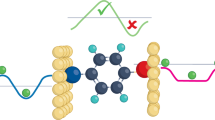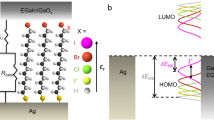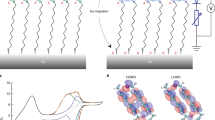Abstract
Virtually all types of molecular electronic devices depend on electronically addressing a molecule or molecular layer through the formation of a metallic contact. The introduction of molecular devices into integrated circuits will probably depend on the formation of contacts using a vapour deposition technique, but this approach frequently results in the metal atoms penetrating or damaging the molecular layer. Here, we report a method of forming ‘soft’ metallic contacts on molecular layers through surface-diffusion-mediated deposition, in which the metal atoms are deposited remotely and then diffuse onto the molecular layer, thus eliminating the problems of penetration and damage. Molecular junctions fabricated by this method exhibit excellent yield (typically >90%) and reproducibility, and allow examination of the effects of molecular-layer structure, thickness and contact work function.
This is a preview of subscription content, access via your institution
Access options
Subscribe to this journal
Receive 12 print issues and online access
$259.00 per year
only $21.58 per issue
Buy this article
- Purchase on Springer Link
- Instant access to full article PDF
Prices may be subject to local taxes which are calculated during checkout





Similar content being viewed by others
References
Bergren, A. J., Harris, K. D., Deng, F. J. & McCreery, R. L. Molecular electronics using diazonium-derived adlayers on carbon with Cu top contacts: critical analysis of metal oxides and filaments. J. Phys. Condens. Matter 20, 374117 (2008).
Choi, S. H., Kim, B. & Frisbie, C. D. Electrical resistance of long conjugated molecular wires. Science 320, 1482–1486 (2008).
Xu, B. & Tao, N. J. Measurement of single-molecule resistance by repeated formation of molecular junctions. Science 301, 1221–1223 (2003).
Blum, A. S. et al. Molecularly inherent voltage-controlled conductance switching. Nature Mater. 4, 167–172 (2005).
Chabinyc, M. L. et al. Molecular rectification in a metal–insulator–metal junction based on self-assembled monolayers. J. Am. Chem. Soc. 124, 11730–11736 (2002).
Scott, A., Janes, D. B., Risko, C. & Ratner, M. A. Fabrication and characterization of metal–molecule–silicon devices. Appl. Phys. Lett. 91, 033508 (2007).
Metzger, R. M., Xu, T. & Peterson, I. R. Electrical rectification by a monolayer of hexadecylquinolinium tricyanoquinodimethanide measured between macroscopic gold electrodes. J. Phys. Chem. B 105, 7280–7290 (2001).
Wang, W. et al. Probing molecules in integrated silicon–molecule–metal junctions by inelastic tunneling spectroscopy. Nano Lett. 8, 478–484 (2008).
Richter, C. A., Stewart, D. R., Ohlberg, D. A. A. & Williams, R. S. Electrical characterization of Al/AlOx/molecule/Ti/Al devices. Appl. Phys. A 80, 1355–1362 (2005).
Love, J. C., Estroff, L. A., Kriebel, J. K., Nuzzo, R. G. & Whitesides, G. M. Self-assembled monolayers of thiolates on metals as a form of nanotechnology. Chem. Rev. 105, 1103–1169 (2005).
McCreery, R. L. & Bergren, A. J. Progress with molecular electronic junctions: meeting experimental challenges in design and fabrication. Adv. Mater. 21, 4303–4322 (2009).
Walker, A. V. et al. The dynamics of noble metal atom penetration through methoxy-terminated alkanethiolate monolayers. J. Am. Chem. Soc. 126, 3954–3963 (2004).
Anariba, F., DuVall, S. H. & McCreery, R. L. Mono- and multilayer formation by diazonium reduction on carbon surfaces monitored with atomic force microscopy ‘scratching’. Anal. Chem. 75, 3837–3844 (2003).
Richter, C. A., Hacker, C. A. & Richter, L. J. Electrical and spectroscopic characterization of metal/monolayer/Si devices. J. Phys. Chem. B 109, 21836–21841 (2005).
Walker, A. V. et al. Chemical pathways in the interactions of reactive metal atoms with organic surfaces: vapor deposition of Ca and Ti on a methoxy-terminated alkanethiolate monolayer on Au. J. Phys. Chem. B 109, 11263–11272 (2005).
Haick, H. & Cahen, D. Making contact: connecting molecules electrically to the macroscopic world. Prog. Surf. Sci. 83, 217–261 (2008).
Zhu, Z. H. et al. Controlling gold atom penetration through alkanethiolate self-assembled monolayers on Au {111} by adjusting terminal group intermolecular interactions. J. Am. Chem. Soc. 128, 13710–13719 (2006).
Haick, H., Ambrico, M., Ghabboun, J., Ligonzo, T. & Cahen, D. Contacting organic molecules by metal evaporation. Phys. Chem. Chem. Phys. 6, 4538–4541 (2004).
Van Hal, P. A. et al. Upscaling, integration and electrical characterization of molecular junctions. Nature Nanotech. 3, 749–754 (2008).
Ranganathan, S. & McCreery, R. L. Electroanalytical performance of carbon films with near-atomic flatness. Anal. Chem. 73, 893–900 (2001).
Brooksby, P. A. & Downard, A. J. Electrochemical and atomic force microscopy study of carbon surface modification via diazonium reduction in aqueous and acetonitrile solutions. Langmuir 20, 5038–5045 (2004).
Pinson, J. & Podvorica, F. Attachment of organic layers to conductive or semiconductive surfaces by reduction of diazonium salts. Chem. Soc. Rev. 34, 429–439 (2005).
Kariuki, J. K. & McDermott, M. T. Formation of multilayers on glassy carbon electrodes via the reduction of diazonium salts. Langmuir 17, 5947–5951 (2001).
Deinhammer, R. S., Ho, M., Anderegg, J. W. & Porter, M. D. Electrochemical oxidation of amine-containing compounds—a route to the surface modification of glassy-carbon electrodes. Langmuir 10, 1306–1313 (1994).
Liu, C. L., Cohen, J. M., Adams, J. B. & Voter, A. F. EAM study of surface self-diffusion of single adatoms of FCC metals Ni, Cu, Al, Ag, Au, Pd and Pt. Surf. Sci. 253, 334–344 (1991).
Speller, S., Molitor, S., Rothig, C., Bomermann, J. & Heiland, W. Surface mobility on the Au(110) surface observed with scanning tunneling microscopy. Surf. Sci. 312, L748–L752 (1994).
Racz, Z. & Seabaugh, A. Characterization and control of unconfined lateral diffusion under stencil masks. J. Vac. Sci. Technol. B 25, 857–861 (2007).
Reddy, P., Jang, S. Y., Segalman, R. A. & Majumdar, A. Thermoelectricity in molecular junctions. Science 315, 1568–1571 (2007).
Beebe, J. M., Kim, B., Frisbie, C. D. & Kushmerick, J. G. Measuring relative barrier heights in molecular electronic junctions with transition voltage spectroscopy. ACS Nano 2, 827–832 (2008).
Yan, H. J. & McCreery, R. L. Anomalous tunneling in carbon/alkane/TiO2/gold molecular electronic junctions: energy level alignment at the metal/semiconductor interface. ACS Appl. Mater. Interfaces 1, 443–451 (2009).
Engelkes, V. B., Beebe, J. M. & Frisbie, C. D. Length-dependent transport in molecular junctions based on SAMs of alkanethiols and alkanedithiols: effect of metal work function and applied bias on tunneling efficiency and contact resistance. J. Am. Chem. Soc. 126, 14287–14296 (2004).
Holmlin, R. E. et al. Electron transport through thin organic films in metal–insulator–metal junctions based on self-assembled monolayers. J. Am. Chem. Soc. 123, 5075–5085 (2001).
Abelmann, L. & Lodder, C. Oblique evaporation and surface diffusion. Thin Solid Films 305, 1–21 (1997).
Anariba, F. et al. Comprehensive characterization of hybrid junctions comprised of a porphyrin monolayer sandwiched between a coinage metal overlayer and a Si(100) substrate. J. Phys. Chem. C 112, 9474–9485 (2008).
Nowak, A. M. & McCreery, R. L. Characterization of carbon/nitroazobenzene/titanium molecular electronic junctions with photoelectron and Raman spectroscopy. Anal. Chem. 76, 1089–1097 (2004).
Ibach, H. Physics of Surfaces and Interfaces (Springer, 2006).
Acknowledgements
The authors acknowledge financial support from the National Sciences and Research Council of Canada, the Alberta Ingenuity Fund, the University of Alberta, and the National Institute for Nanotechnology (NINT). We acknowledge P. Li for FIB-TEM analysis, K. Harris and H. Yan for scientific discussions, and B. Szeto for technical assistance.
Author information
Authors and Affiliations
Contributions
A.B. and R.M. conceived and designed the experiments, A.B. performed the experiments, A.B. and R.M. co-wrote the manuscript and Supplementary Information.
Corresponding author
Ethics declarations
Competing interests
The authors declare no competing financial interests.
Supplementary information
Supplementary information
Supplementary information (PDF 4799 kb)
Rights and permissions
About this article
Cite this article
Bonifas, A., McCreery, R. ‘Soft’ Au, Pt and Cu contacts for molecular junctions through surface-diffusion-mediated deposition. Nature Nanotech 5, 612–617 (2010). https://doi.org/10.1038/nnano.2010.115
Received:
Accepted:
Published:
Issue Date:
DOI: https://doi.org/10.1038/nnano.2010.115
This article is cited by
-
Nanoscale molecular rectifiers
Nature Reviews Chemistry (2023)
-
P-type electrical contacts for 2D transition-metal dichalcogenides
Nature (2022)
-
On-chip integrated process-programmable sub-10 nm thick molecular devices switching between photomultiplication and memristive behaviour
Nature Communications (2022)
-
Making clean electrical contacts on 2D transition metal dichalcogenides
Nature Reviews Physics (2021)
-
Concepts in the design and engineering of single-molecule electronic devices
Nature Reviews Physics (2019)



